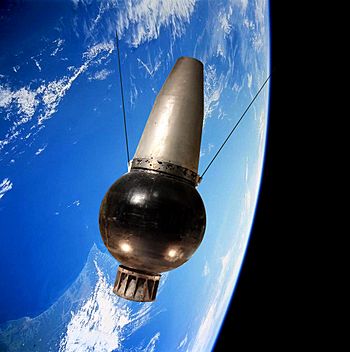Ohsumi (satellite) facts for kids

Artist's rendition of Ohsumi in orbit.
|
|
| Mission type | Earth science |
|---|---|
| Operator | Institute of Space and Aeronautical Science, University of Tokyo (now part of JAXA) |
| Spacecraft properties | |
| Launch mass | 24.0 kilograms (52.9 lb) |
| Power | 10.3 watt |
| Start of mission | |
| Launch date | February 11, 1970, 04:25 UTC |
| Rocket | Lambda-4S |
| Launch site | Kagoshima LA-L |
| Contractor | ISAS |
| End of mission | |
| Last contact | February 12, 1970 |
| Decay date | August 2, 2003 |
| Orbital parameters | |
| Reference system | Geocentric |
| Regime | Medium Earth |
| Eccentricity | 0.262379 |
| Perigee | 350 kilometres (220 mi) |
| Apogee | 5,140 kilometres (3,190 mi) |
| Inclination | 31.0 degrees |
| Period | 144.0 minutes |
| Epoch | 10 February 1970, 23:25:00 UTC |
Ohsumi (pronounced "Oh-soo-mee") was Japan's very first satellite to successfully reach orbit around Earth! It was a huge step for Japan in space exploration.
This pioneering satellite was launched on February 11, 1970, at 4:25 AM UTC. It blasted off from the Uchinoura Space Center in Japan. The team behind this amazing achievement was the Institute of Space and Aeronautical Science, part of the University of Tokyo. Today, this group is known as JAXA, Japan's national space agency.
With Ohsumi's launch, Japan became only the fourth country in the world to put its own satellite into orbit. Before Japan, only the USSR, the United States, and France had achieved this feat. The satellite was named after the Ōsumi Peninsula, a place in Japan where the launch site was located.
Japan's First Step into Space
Ohsumi was a small but mighty satellite, weighing about 24 kilograms (around 53 pounds). It was launched using a special rocket called the Lambda 4S-5. This rocket was designed to carry small payloads like Ohsumi into space.
The successful launch of Ohsumi showed the world that Japan had developed its own advanced rocket technology. This was a major milestone for the country's science and engineering. It opened the door for many more Japanese satellites and space missions in the future.
Ohsumi's Mission and Orbit
Ohsumi's main goal was to test if Japan could successfully launch a satellite into orbit. It didn't carry complex scientific instruments like some later satellites. Its mission was primarily about proving the technology.
Once in space, Ohsumi entered an elliptical orbit around Earth. At its closest point (periapsis), it was about 350 kilometers (217 miles) from Earth. At its farthest point (apoapsis), it was about 5,140 kilometers (3,194 miles) away. Each trip around Earth took about 144 minutes.
What Happened to Ohsumi?
Ohsumi's mission was short but successful. It stopped sending signals just one day after its launch, on February 12, 1970. Even though it was silent, it continued to orbit Earth for many years.
Eventually, like many old satellites, Ohsumi lost altitude and fell back into Earth's atmosphere. It burned up safely on August 2, 2003. Ohsumi will always be remembered as the satellite that started Japan's journey into space!
See Also
- Timeline of artificial satellites and space probes
- In Spanish: Osumi (satélite) para niños

